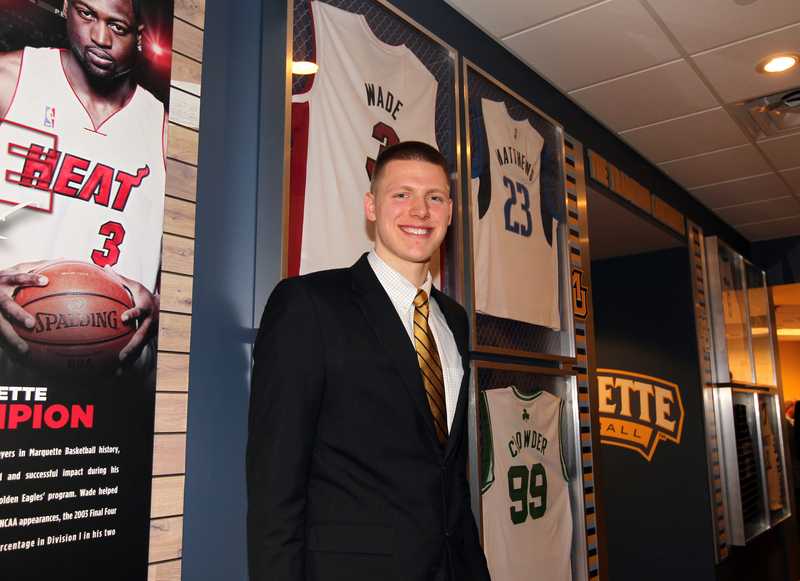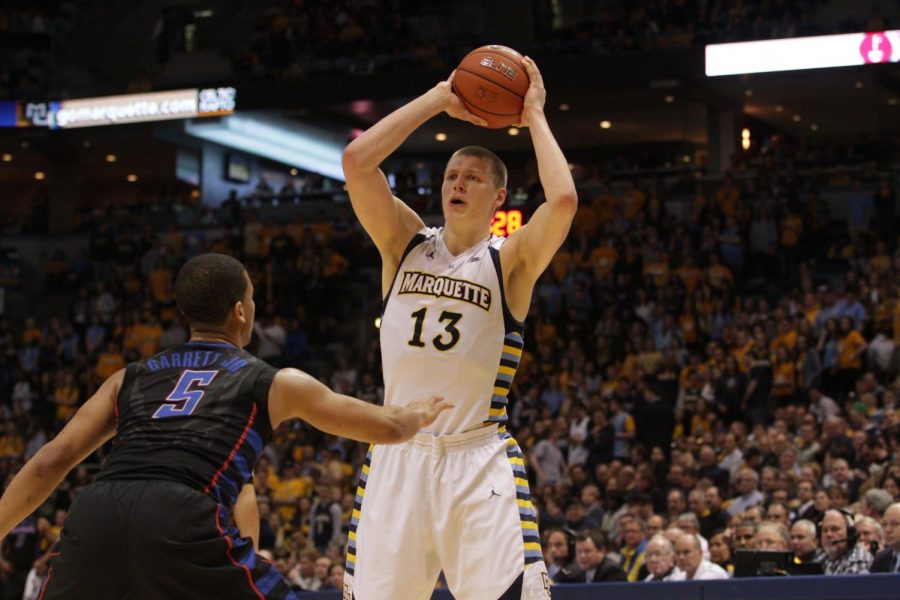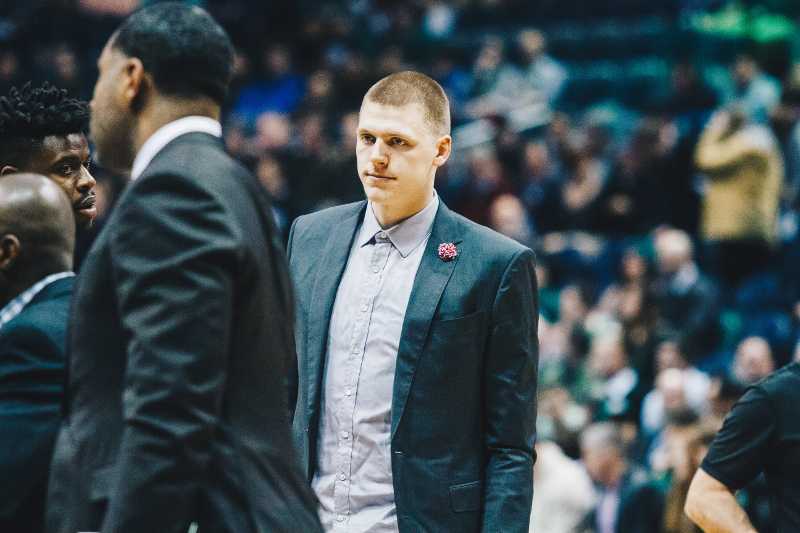When most of the Marquette basketball community last saw Henry Ellenson, he was averaging a double-double during an uninspiring 2015-’16 season that turned out to be his only year in Milwaukee. The Detroit Pistons scooped Ellenson up with the 18th pick in the 2016 NBA Draft and he’s since existed on the NBA/G-League border.
Ellenson struggled to find the jump shot that was supposed to set him apart from other big men in his first year. He hit on only 36 percent of his shots from the field. Concerns persisted throughout the season about defense and strength, as this Detroit Free Press article highlights. Those expecting Ellenson to have an immediate impact probably left last season feeling disappointed.
His performance in the annual NBA Summer League probably has that same group of people feeling the exact opposite way. He averaged 17.4 points per game over five games on 44 percent shooting, including an impressive 29-point performance in Detroit’s win over the Charlotte Hornets. While the correlation Summer League performance has to actual NBA season performance is questionable, Ellenson has looked a lot more comfortable these last two weeks.
Let’s also remember that Ellenson still isn’t old enough to legally rent a car yet, so there’s more reason to think his summer performance is a sign of improvement than there would be for a six-year veteran in the same position.
Before we break down the film on Ellenson, there are two necessary disclaimers to put out there. While I watched as much of Ellenson’s games live as I could, the only video replays I have access to are 10-minute highlight compilations of each game put out by the NBA. They contain every significant play, but leave out the mundane ones that could be more telling. (i.e. All of Ellenson’s made shots are in the highlights. Only a few of his misses are in there too.) I’ve done my best to pick a representative video sample.
Secondly, summer leagues are for players to gain experience and for teams to evaluate talent. A player’s tactics might deviate from the norm based on what his coaches or trainers told him to improve. For instance, I rarely saw Ellenson do any low-post moves in summer league. Is that because he’s truly a perimeter-only player now, or is it because his coaches told him to focus on his shot during a period of time where the game results don’t matter? It’s hard to say.
Alright, with those two disclaimers out of the way, let’s begin with the thing that has everyone raving about Ellenson: his shot.
(Ellenson is wearing number eight in these clips in case you’re having trouble locating him.)
Isn’t that pretty? Even when Ellenson was clanging three-pointers at Marquette, his solid free throw percentage and fluid shooting motion suggested there was plenty of room to grow. All of a sudden, we’re getting a really good sense for what that growth might look like.
Here’s an example that encapsulates what the Pistons saw in the big man from Rice Lake, Wisconsin. Rashawn Thomas is playing tight defense on Ellenson in the corner, so this is going to be a hard shot to create, let alone make. Ellenson switches hands, shows off his improved strength by backing the 230-pound Thomas down from the wing to the edge of the paint, then turns around and buries a jumper with a hand in his face.
That fade-away shot, if done correctly, is basically unblockable because of Ellenson’s 6-foot-11 frame and high release point. Whoever is defending him has to be a certain height or wingspan to get anywhere close to contesting it. The problem is that big guys don’t tend to be comfortable defending on the perimeter, which creates mismatch opportunities. This is why players like Giannis Antetokounmpo and Kristaps Porzingis are so effective on offense. Ellenson obviously isn’t in the same ball-handling class as Giannis or shooting class as Porzingis, but the potential exists for Ellenson to pose a lesser version of the same matchup problems if he can perfect the move he made on Thomas.
Here’s another clip that demonstrates those matchup problems. Notice how Henry Ellenson puts Luke Kornet of the Knicks on his heels with smart dribbling. Most big guys just aren’t cut out to defend this.
Another thing that has taken shape really nicely over the summer is Ellenson’s pick-and-pop game. I was really looking forward to him doing a lot of it at Marquette and it never really materialized because of bad spacing and generally inconsistent guard play. The clip below is what you get with an improved stroke, not to mention guards that can take some pressure off of him.
He must have done that at least half a dozen times just in the tape I saw.
A good pick and pop game will help with Ellenson’s shot selection, which is a much bigger issue than his stroke. Anybody who watched him at Marquette knows he took too many threes with a defender on top of him. That problem still exists. Even though Ellenson made the shot below, by the time he gathered to take it, Josh Huestis was in position to contest. He probably should have passed it up.
(This is an instance where the lack of complete replays hurts the analysis a bit. Ellenson’s 33 percent shooting mark from three shows he missed more of those tightly-guarded shots than he made.)
It’s a kind of shocking to realize how much Ellenson played the role of shooter and, by contrast, how little time he spent in the paint. Rudimentary post play led to a big chunk of his scoring production at Marquette even though he was never a true back-to-the-basket big. I’ve seen sparse, if any, evidence of those same post moves in summer league. Instead, Ellenson seemed to always be rotating around the perimeter waiting for a kick out, even when he had an open lane to the basket.
The play below this paragraph is the most illustrative case of the difference between Marquette Henry and pro Henry that I found. Ellenson sets up near the left block. Almost immediately, Huestis rotates away to provide help defense on the driving Lorenzo Brown. Ellenson is left with nobody on him right next to the basket; prime position to either receive a pass for a layup or clean up a potential miss. Watch what he does instead:
This is an instance where more context would be really helpful. It’s possible the Pistons were running a set play that called for Ellenson to run beyond the three-point line and set up for a shot. It’s also possible that Ellenson is supposed to clear the lane on that play to give the driver room. Still, it’s pretty unusual to see a natural rebounder move so far away from the basket in that situation.
I’m not suggesting Ellenson’s rebounding chops have diminished; the stat sheet and tape both indicate that they haven’t. What this does suggest is a divergence between position and role. At Marquette, Ellenson was a hybrid interior and wing player that had a ball-handling component to his game, which isn’t an odd role for a guy labeled as a power forward. Now it looks like the interior part is getting phased out to accommodate more perimeter play, at least as far as offense is concerned.
In other words, he wasn’t doing any of this on offense:
Moving to the outside might unlock a part of Ellenson’s game that was dormant at Marquette: his passing. Hanging out in a crowded frontcourt surrounded by guys that didn’t move well without the ball severely constrained his ability to distribute in Milwaukee. Although he only showed flashes of what’s possible, Ellenson can open up the floor in a whole new way if he masters finding guards with bounce passes.
There are two problems that I saw on Ellenson’s tape: one short-term and one long-term. The first is turnovers. To be fair, he only committed six of them through his first four games. It would have counted as a huge improvement if he maintained that pace. Alas, he gave the ball away five times against the Mavericks in the finals, which made his turnovers per game mark roughly the same as it was at Marquette. (2.2 in summer league compared to 2.4 as a Golden Eagle.)
Anything over two is suboptimal, especially for a guy that isn’t doing a lot of ball-handling. Ellenson spent the first four games mostly avoiding bad tendencies he displayed at Marquette: dribbling himself into double-teams, trying to fit passes in between two defenders, stuff like that. It all came back in the final game, though, a game where he scored five points on two of 10 shooting. Unfortunately, the championship game’s highlight montage doesn’t have any of his turnovers, so here’s one from an earlier game that’s pretty representative of later transgressions.
It’s relatively easy to clean something like that up, though. The longer-term problem for Ellenson is that his offensive and defensive roles are pretty different. We already went over what he does on offense; he’s a wing shooter that has a perimeter game. Having Ellenson play that same role on defense – guard the opponent’s wing – can be dicey. Sometimes it works, like it did here against Okaro White of the Miami Heat. Ellenson stays home on the crossover, contests the shot without fouling and works himself into good rebounding position.
That’s not how it went the majority of the time. Just a few minutes earlier, White created space on Ellenson with a pump fake, then took him to the hoop before he could recover for an and-one. White’s 29 points, most of them on Ellenson, suggest that having the former Marquette big man defend NBA wings will result in more possessions like the one below instead of the one above.
In order for the vast majority of players to get significant minutes on good NBA teams, they need to be able to answer the question, “who can you guard?” The guys who don’t have to answer that question are offensive powerhouses like James Harden or Damian Lillard. Ellenson obviously isn’t in that category at the moment. Right now, I’m not sure who Ellenson guards. That’s the next problem he and his coaches have to solve. Does he try to be a rim protector on defense? Can he get to be just a little bit twitchier? And what about his pick-and-roll defense, a big weak point at Marquette that we didn’t see a lot of in summer league?
Fortunately for Ellenson, he’s at the age where those questions don’t have to be answered right now. He’s still developing and it’s fair to say that his performance in the Orlando Pro Summer League was a significant step forward in that process. It’s the surest sign yet that Ellenson is ready to move out of the G-League and take a serious run at the big time.





